
Trillium chloropetalum, also known as giant trillium, giant wakerobin, or common trillium, is a species of flowering plant in the family Melanthiaceae. It is endemic to the western U.S. state of California, being especially frequent in and around the San Francisco Bay Area.

Ageratina altissima, also known as white snakeroot, richweed, or white sanicle, is a poisonous perennial herb in the family Asteraceae, native to eastern and central North America. An older binomial name for this species is Eupatorium rugosum, but the genus Eupatorium has undergone taxonomic revision by botanists, and a number of the species that were once included in it have been moved to other genera.
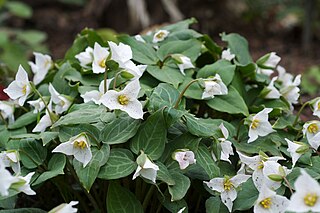
Pseudotrillium is a monotypic genus of flowering plants in the family Melanthiaceae containing the single species Pseudotrillium rivale. The genus was proposed in 2002 on the basis of morphology and molecular evidence that suggest the plant should no longer be included in genus Trillium.
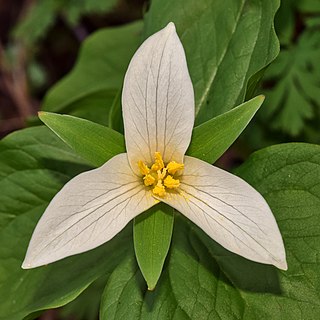
Trillium ovatum, the Pacific trillium, also known as the western wakerobin, western white trillium, or western trillium, is a species of flowering plant in the family Melanthiaceae. It is found in western North America, from southern British Columbia and the tip of southwestern Alberta to central California, east to Idaho and western Montana. There is an isolated population in northern Colorado and southern Wyoming.

Ageratina herbacea is a North American species of flowering plants in the family Asteraceae known by the common names fragrant snakeroot and Apache snakeroot. It is native to desert regions of the southwestern United States and northern Mexico. It grows in rocky slopes in conifer forests and woodlands.
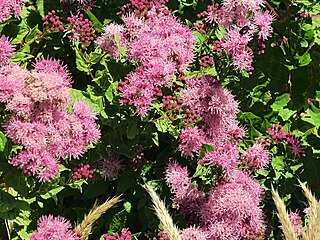
Ageratina occidentalis is a species of flowering plant in the family Asteraceae known by the common name western snakeroot or western eupatorium. It is native to the western United States where it grows in several types of habitat. It is found in California, Oregon, Washington, Idaho, Montana, Nevada, and Utah.

Allium cratericola is a species of wild onion known by the common name Cascade onion. It is endemic to California, where is an uncommon member of the flora in several of the state's mountain ranges, including the northern and southern California Coast Ranges, the western Transverse Ranges, Klamath Mountains, and the Sierra Nevada foothills. Its range covers much of the state, from Riverside County to Siskiyou County.
Allium hoffmanii is a species of wild onion known by the common name beegum onion. It is native to northern California, where it grows in the serpentine soils of the local mountain ranges in Siskiyou, Humboldt, Trinity, Shasta, and Tehama Counties.
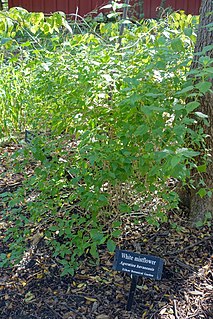
Ageratina havanensis, the Havana snakeroot or white mistflower, is a species of flowering shrub in the family Asteraceae, native to the south-western United States (Texas), Cuba, and north-eastern and east-central Mexico. Unlike many other species of Ageratina, it is evergreen.

Chaenactis nevadensis, with the common name Nevada dustymaiden, is a North American species of flowering plant in the daisy family.

Chaenactis suffrutescens is a species of flowering plant in the aster family known by the common name Shasta chaenactis.
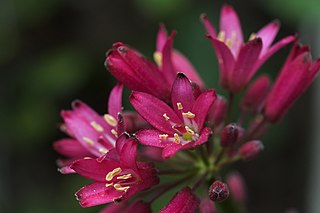
Clintonia andrewsiana is a species of flowering plant in the lily family Liliaceae. The species was discovered by John Milton Bigelow in 1854 and described by John Torrey in 1856. The specific epithet andrewsiana honors Timothy Langdon Andrews (1819–1908), a "gentleman who assiduously examined the botany" of California during the mid-19th century. The species is commonly known as Andrews clintonia or red clintonia, where the latter refers to the color of the flowers. In California, it is also known as bluebead lily or western bluebead lily, not to be confused with C. borealis, which is likewise known as bluebead lily. The Pomo people of northern California considered the plant to be poisonous.
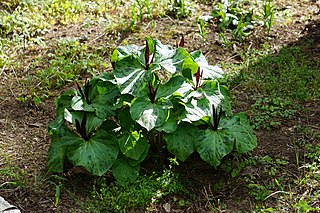
Trillium angustipetalum, with the common name is narrowpetal wakerobin, is a species of Trillium, plants which may be included within the Liliaceae or the newer family Melanthiaceae.

Ageratina luciae-brauniae is a species of flowering plant in the family Asteraceae known by the common names Lucy Braun's snakeroot and rockhouse white snakeroot. It is native to the eastern United States, where it is limited to the Cumberland Plateau of Kentucky and Tennessee. It may also occur in South Carolina but these reports are unconfirmed.
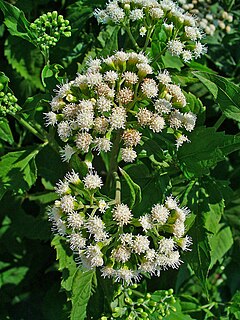
Ageratina aromatica, also known as lesser snakeroot and small-leaved white snakeroot, is a North American species of plants in the family Asteraceae. It is widespread and common across much of the eastern and southern United States from Louisiana to Massachusetts, as far inland as Kentucky and Ohio.
Ageratina jucunda, called the Hammock snakeroot, is a North American species of plants in the family Asteraceae. It is found only in the southeastern United States, in the states of Georgia and Florida.
Ageratina lemmonii, called the Lemmon's snakeroot, is a North American species of plants in the family Asteraceae. It is found only in the southwestern United States in the states of Arizona and New Mexico, as well as the states of Sonora, Sinaloa, Chihuahua and Durango in Mexico.
Ageratina paupercula, called the Santa Rita snakeroot, is a North American species of shrubs or perennial herbs in the family Asteraceae. It is found only in the states of Arizona, Sonora, Chihuahua, Durango, Nayarit, and Jalisco.
Ageratina rothrockii is a North American species of plants in the family Asteraceae. It is found only in the southwestern United States in the states of Arizona, New Mexico, and Texas, as well as the states of Sonora, Coahuila, Chihuahua, and Durango in Mexico.
Balsamorhiza lanata, with the common name lanate balsamroot, is a species of plant in the tribe Heliantheae of the family Asteraceae native to California.















